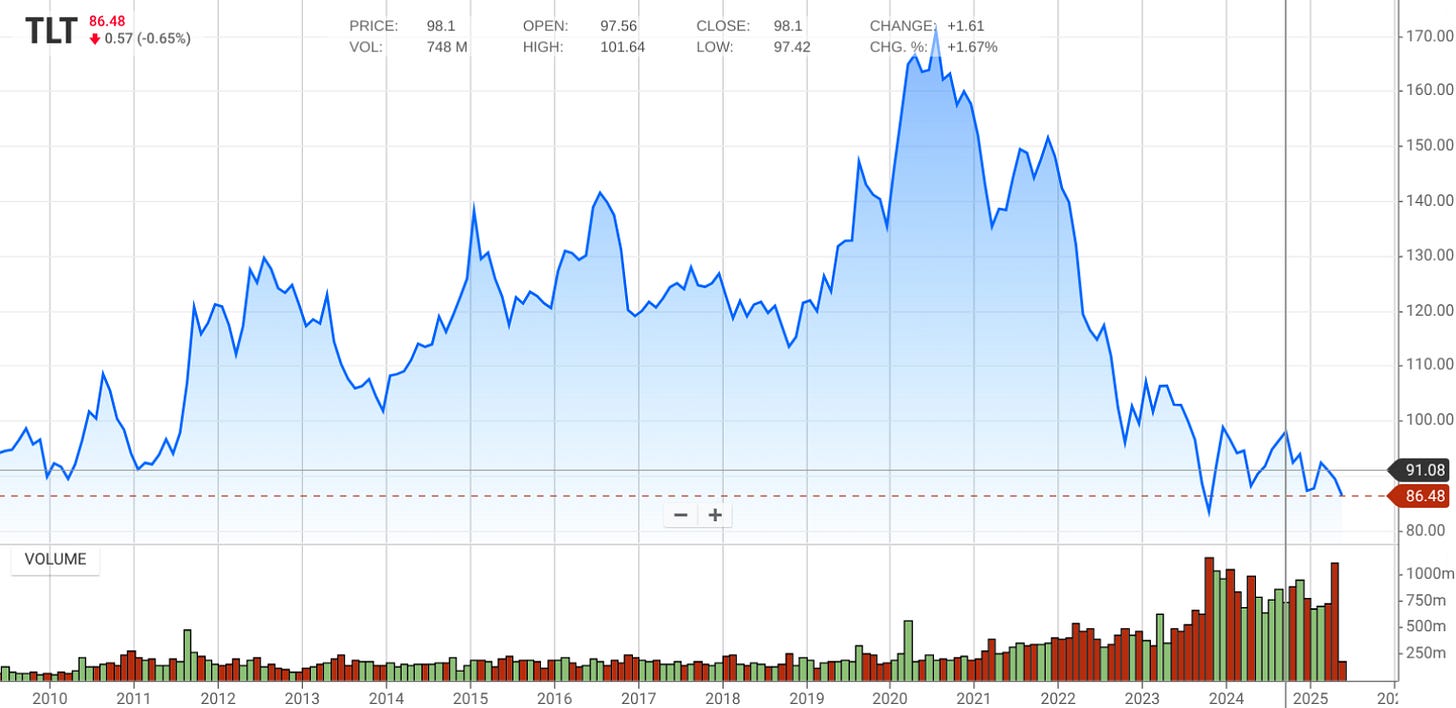California’s long war on its in-state refineries has been a primary factor behind the highest gasoline prices in the country. Per the above image, pump prices are pushing $5 per gallon versus the national average of $3.136. (By the way, the lowest is Mississippi at $2.85, contrary to POTUS assertions.) The closure of two Phillips 66 facilities will leave the Golden State with just seven refineries within its borders. As a result, gas prices may rise even higher. CA is already being forced to import gasoline from overseas to meet its gas consumption needs. This is both costly and polluting (bunker fuel for tankers is the residue from oil refining; thus, it contains a high level of impurities and waste products).
The most widely traded long-term treasury bond ETF is TLT. Unsurprisingly, it’s been in a vicious downtrend since bond yields bottomed in 2020. Last year, it broke 15-year support around $91. In the Haymaker way of looking at the world, that’s a very negative development. Federal deficits that are rising from already grotesque levels are undoubtedly part of the weakness.
Overseas investors divesting their long-term U.S. Treasurys (USTs) is almost certainly another culprit. Moreover, there is an additional factor that may soon be exerting further downward pressure on long-term bond prices, per the work of market maven extraordinaire Kevin Muir. In a note he published today, Kevin pointed out that due to obscure technicalities with the 30-year UST futures contract, it appears to be creating a situation where holders of those are experiencing unintended duration extension as prices fall, which they’ve been doing lately. This means, in English, that the effective maturity length of the contracts they hold could be on the verge of increasing dramatically.
Asset managers currently hold the highest level of 30-year T-bond contracts over the last 20 years. Kevin believes most of them are unaware of the esoteric details behind what could be a significant duration extension. Consequently, he feels it has the potential to be an unpleasant shock that might destabilize the long-term UST market. This is the opposite of what the Trump administration wants to see.
“As a result of these (oil drilling rig and frack crew cuts), it is likely that U.S. onshore oil production has peaked and will begin to decline this quarter. This will have a meaningful impact on our industry and our country.” -Travis Stice, Diamondback Energy CEO
“(Warren) Buffett had a 60-year record of double-digit compounding returns. That’s a record I don’t think will be broken. It’s like John Wooden at UCLA when he won 10 NCAA basketball titles.” -Tom Gayner, CEO of Markel Group, viewed by some as a company with Berkshire Hathaway-like characteristics.
An Homage to the Oracle
Before getting into the main message of this Making Hay Monday (MHM), I wanted to make two apologies. The first item is relatively minor, but it does need correcting.
Last week, I wrote that the oil futures market had moved into a condition known as contango. That’s where the more distant contract months trade at a premium to the current or spot month. Actually, that’s the typical upward slope of most commodity contracts. The inverse is known as backwardation because it’s the inverse of normal.
As I’ve written in the past, including last week, the latter condition is similar to an interest-rate yield curve inversion when short-term rates are higher than longer rates. Both are aberrational situations but for the oil and interest rate markets those odd conditions have been, until recently, in place for several years. In other words, this has been an unusually long period in the “upside down” for both.
Ironically, in each case they have normalized lately, but to varying degrees. Short-term interest rates are now definitely below long rates and I wrote last week that the steepness of the oil futures curve was even more pronounced. Yet, that’s not the case and it’s the reason for this apology.
My usually trusty AI tool, Perplexity, gave me a bad number for the one-year-out West Texas Intermediate (WTI) oil contract. Despite checking it a few times, I should have dug deeper because the premium seemed high to me. Candidly, I’m not as proficient at this point on Bloomberg as I should be and that incredible, but incredibly complex, system would have provided the correct data.
The reality is that the oil market is essentially flat one year out. In other words, prices for near-term oil delivery are roughly the same as they are for June 2026. This means that the most popular crude oil ETF, USO, is a decent way to play an oil price recovery. As I wrote last week, when the normal contango status exists, USO faces a drag, or built-in loss, assuming flat oil prices. Frequently, the so-called “roll loss” is significant. But when the out-contracts are priced the same as the nearby ones, there’s no penalty.
However, almost every story about oil these days is bearish, so there doesn’t appear to be much interest in playing a price rebound. As has happened repeatedly in the past, that’s exactly when crude has tended to come alive. (Partially due to the U.S./China tariff detente, it has popped nearly 10% in just the last five trading days.) But, as I also noted last week, oil did break critical support in the upper-60s last month and, as usual, it fell sharply post that breakdown.
(For those with a keen interest in oil, we’ve provided a link at the end of this MHM to a recent podcast with one of the world’s foremost experts on this market, Anas Alhajji, and MacroVoices’ Erik Townsend. The super-distilled version is that Anas believes global crude inventories are very low and that the OPEC production increase has caused misguided negativity toward oil. If you have much in the way of energy exposure, and/or are considering adding to it, I’d highly recommend you take the time to listen to this podcast.)
My other mea culpa is more serious and relates to my bullish stance on Atlas Energy (AESI). Last week, it reported extremely soft Q1 results and also issued disappointing guidance for Q2. It has now relinquished a quarter of its value from when I highlighted it on April 1st. (Yes, I was a fool to tout it then, in hindsight).
Like oil, AESI is in a wicked downtrend and it’s hazardous to opine on when it will end for either one. But what I do know is that oil is essential for modern life, despite rumors and passionate beliefs, of which there are many, to the contrary. It’s merely being factual to note that U.S. crude production has become essential to meeting global oil demand growth, and also that it has plateaued. Based on prevailing prices below the break-even point for many, if not most, shale producers, it is a low-odds bet output is heading for a contraction. For instance, the drilling rig count has already tumbled by 22% since the end of 2022 and it is almost certainly heading lower from here, perhaps considerably.
Validating that last paragraph, the CEO of Diamondback Energy (FANG), Travis Stice, made some shocking statements last week, garnering worldwide attention. His comments triggered a much-needed snapback in crude prices. (FANG is widely considered one of the premier U.S. shale oil producers, if not numero uno.) He told the world that not only is U.S. shale production peaking, it’s going to head lower almost immediately. As we’ve noted before, America’s shale basins have grown their output by a stupendous 12 million barrels per day (bpd) over the last 15 years. (This includes natural gas liquids.) OPEC, conversely, has increased its production by just 4.7 million bpd. Ergo, if he is right, this is really big — and alarming — news.






